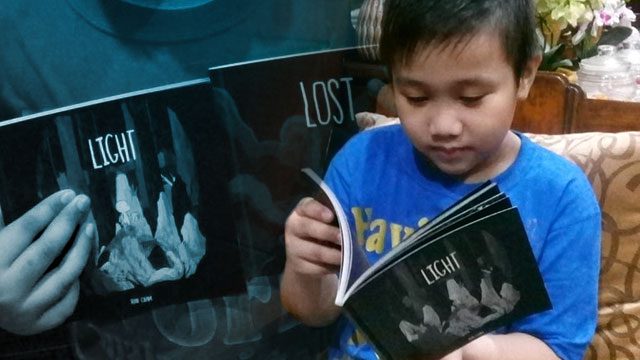SUMMARY
This is AI generated summarization, which may have errors. For context, always refer to the full article.

ALBAY, Philippines – To encourage a love of books, a child doesn’t necessarily have to be able to read words. Ask someone who got a terrific jump-start from comics or graphic novels, if not parents or kin who know one. (READ: Bedtime stories: 7 PH children’s books that even adults will enjoy)
Avie Uy, whose then 7-year-old cousin Benedique John Vidad was a reluctant reader, can attest to that. She said her cousin was easily intimidated by worded books. This was until she showed him Light and Lost, silent (wordless) graphic novels by Baguio-based artist Rob Cham.
Light is a graphic novel series that follows a backpack-toting adventurer who’s on a quest to find treasure. It’s published by Anino Comics, an imprint of Adarna House Inc, which has a vision to “cater to readers fascinated by stories told and rendered in artful visuals.”
A paper titled Selected Philippine Wordless Graphic Novels and Komiks: A Semiotic and Thematic Analysis by Arnold Buenaflor of University of the Philippines Baguio explains that silent graphic novels get their name from their reliance on “illustrations on each page to tell the narrative.”
After reading Light, Avie’s cousin read the second book. Then, he kept on asking for the third book.
“He loved it so much that he started asking me for more books like that,” Avie said.
Before, books with lots of words would easily discourage Benedique because he was struggling with reading at that time. (READ: A Reading Revolution: Students choose their books)
“He would simply put down the book once seeing the words, adding that he couldn’t,” Avie said.
When she told Benedique that she bought him a book with no words and only pictures in it, he was so excited that he asked to take it home.
Eventually, Benedique read books with more and more words. Even now that he can read worded books, he still asks for silent graphic novels, and hopes to get a third sequel of Cham’s Light series, said Avie.
Curiosity as the driving force
While Light and Lost are friendly for all ages, Cham said he didn’t make them specifically for kids.
How it breaks down the language barrier and how kids would find it a less intimidating read – these, he admitted, were not in his mind too and are all new to him.
The fan art he got from kids shown to him by their parents is something he didn’t expect, either.
Light is now on its third reprint. It won the 2016 National Book Award under the category: Best Book of Graphic Literature (Wordless).
Research author Buenaflor explained the appeal of silent graphic novels to young children who are still learning how to read.
“Children are highly visual learners. It is no wonder picture books are heavily connected to children especially in their formative years,” he said.
He added that graphic books also serve as a validation of children’s imagination because what is represented in the pages of these books become the actual representations of these things in the real world for the children. (READ: In Albay, impoverished kids find refuge in summer reading program)
In the end, Buenaflor believes that “curiosity is a driving force in the appeal of graphic novels.”
Bringing excitement to a new level
If graphic books help strengthen children’s world and meaning-making capabilities, the wordless types amplify them into a new level of storytelling, said Buenaflor.
“Having the narrative be interpreted purely based on the schemata and symbolism behind every detail in the text compels the reader to pay attention and turn the page until the end,” he added.
The absence of words in the text further intensifies anticipation.
In cases where children’s experiences really cannot supply any interpretations for the illustrations they are seeing, they are encouraged to ask and that allows them to learn a wide expanse of new information, Buenaflor said.
Cham agreed that it is this sense of wonder and immersive nature that interest young minds in graphic fiction, including wordless ones. He added the ease of use of graphic fiction, especially when young minds haven’t consumed much information yet. (READ: Laguna-based rehab center champions mental health through comic book)
However, Cham is careful not to chalk up how visual books are less intimidating since, for him, that might be underestimating the younger crowd. (READ: Beyond boundaries: Reading children’s lit)
It is certain though that all these result to one thing: motivation.
According to a parenting website which cited psychology journals for an article about reading, it is more important for early learners to develop the love of books, both pictures and stories, than force them to sound the words. Kids learn to read naturally when they have the motivation, among other pre-reading skills, it added.
Applied to Cham’s silent graphic novels, Avie’s cousin couldn’t emphasize more the motivation it gave him with this statement: He liked the book because it was easy to understand, adding that he wasn’t good at reading that time, especially English. – Rappler.com
Add a comment
How does this make you feel?
There are no comments yet. Add your comment to start the conversation.